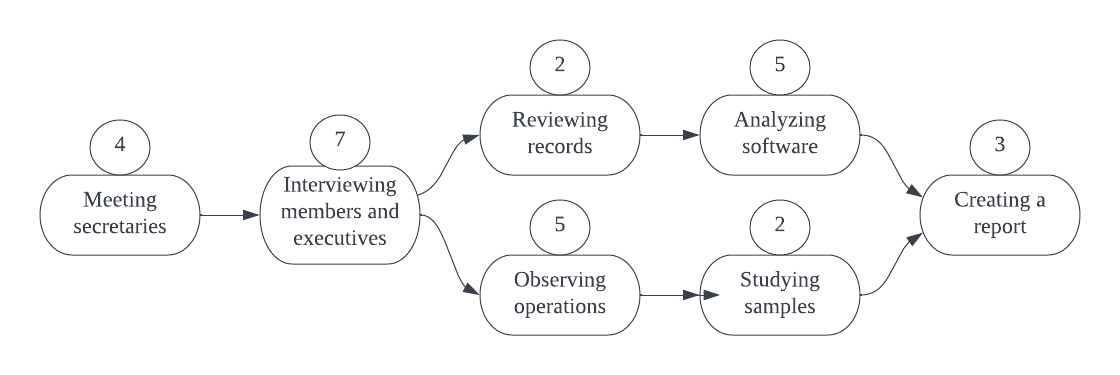Business Information
The project will assist the North Coast Dragon Boating Association (NCDBA), which manages dragon boat racing clubs. Dragon boating is a water sport that involves teams of 22 people – 20 paddlers, a drummer, and a sweep, and two or more teams compete against each other during races. The association’s duties include club rule enforcement and regulation, insurance for teammates, and the creation of an annual racing calendar. However, the association allows its clubs to establish rules, pay additional fees, create merchandise, and more.
Figure 1 presents the executives of the NCDBA, who are responsible for most of the decision-making. Currently, the association uses Microsoft products – MS Office Word and Excel – to conduct its operations, and the clubs can select a paper-based or a computerized system. Overall, the document handling appears unstructured, which raises issues of club members’ safety and the validity of the information submitted to the organization.

The NCDBA managers want to develop and introduce a new information system that would help the organization store and handle all club data in one place. From the conversation with Peter, several areas of interest can be identified. First, as all clubs have the same membership fees and rules, the financial part of the operations can be systematized. Second, the NCDBA offers a range of training courses, such as Coach and Sweep certification and drumming workshops. Here, the area of interest is linked to members’ participation, previously completed courses, grades or documents of completion, and more. Finally, the association deals with scheduling tournaments and overseeing regattas run by large clubs.
Project Management Chart
Table 1. Tasks for the project.


As seen from Table 1, Figures 2 and 3, some tasks can be completed simultaneously, while others require completing the previous steps. Using this data, one can identify the critical path and calculate the overall duration of the project (Ba’Its et al., 2020). According to the created plan, the project should take 24 days. Meeting secretaries and completing interviews require much attention, which will take 11 days.
Following these tasks, observation of operations at a club and a review of records can be done simultaneously, meaning that the two elements of the project will take five days to be completed. Similarly, software analysis and sample studying are independent tasks that may be completed during the same five days. Finally, as the report can be done once all information is completed, it depends on all previous tasks’ completion, and it should take three days.
System Vision
Business Opportunity
The NCDBA is an organization that oversees many clubs which follow a set number of regulations but also have their own rules, which creates a need for a flexible system.
Problem Statement
The NCDBA needs an information system that unites all clubs, manages financial data, records, and certificates of all members, and scheduling for events and training.
Product Position Statement
The Dragon Boat Club Management system includes such features as records of all clubs and their members, financial and insurance data, and previous certifications. Moreover, the system has an integrated calendar with scheduling capabilities for regattas and other events. Finally, the system allows members to apply for training and certificate lessons.
Simplified Risk and Cost-Benefit Analysis
Table 2. Risks associated with the project.
As can be seen from Table 2, some significant risks are ineffective communication, long duration, increased costs, and lack of skills. The project manager should create a transparent plan and estimate completion times; each document should account for potential delays. Next, the budget should also be discussed with the association, and some ways of preventing or mitigating budget overflow should be considered. Finally, the organization’s staff should be educated on how to use the proposed technology.
Benefits include efficient association operation, lowered liability risks, and missed payments. These benefits are tangible, as they increase the effectiveness of workers and decrease the need for additional employees. The cost for the new system includes planning, design, implementation, and training (Mishan & Quah, 2020). If the association does not require additional testing and upgrades, the final product is estimated to cost around $15,000. The benefits will likely lead to stable membership payments and decreased wage expenses, saving approximately $20,000. Thus, the cost-benefit analysis shows a saving of $5,000 in one year after the implementation. Another technique is to consider potential changes in pricing – if the association adds more clubs or members, the benefits will grow.
Initial Feasibility Analysis
Based on the data presented above, the project is feasible. The system will allow the association to manage more clubs and expand its services. Moreover, clubs will be less likely to miss payments or put the organization at risk of liability for uninsured members. As a result, the association may increase its revenue and become more effective at managing clubs. The recommendation for this project is to proceed with creating an information system.
References
Ba’Its, H. A., Puspita, I. A., & Bay, A. F. (2020). Combination of program evaluation and review technique (PERT) and critical path method (CPM) for project schedule development. International Journal of Integrated Engineering, 12(3), 68-75. Web.
Mishan, E. J., & Quah, E. (2020). Cost-benefit analysis. Routledge.